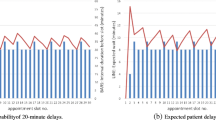Abstract
Efficient staff rostering and patient scheduling to meet outpatient demand is a very complex and dynamic task. Due to fluctuations in demand and specialist availability, specialist allocation must be very flexible and non-myopic. Medical specialists are typically restricted in sub-specialization, serve several patient groups and are the key resource in a chain of patient visits to the clinic and operating room (OR). To overcome a myopic view of once-off appointment scheduling, we address the patient flow through a chain of patient appointments when allocating key resources to different patient groups. We present a new, data-driven algorithmic approach to automatic allocation of specialists to roster activities and patient groups. By their very nature, simplified mathematical models cannot capture the complexity that is characteristic to the system being modeled. In our approach, the allocation of specialists to their day-to-day activities is flexible and responsive to past and present key resource availability, as well as to past resource allocation. Variability in roster activities is actively minimized, in order to enhance the supply chain flow. With discrete-event simulation of the application case using empirical data, we illustrate how our approach improves patient Service Level (SL, percentage of patients served on-time) as well as Wait Time (days), without change in resource capacity.
Similar content being viewed by others
References
Agnetis, A., Coppi, A., Corsini, M., Dellino, G., Meloni, C. & Pranzo, M. (2014). A decomposition approach for the combined master surgical schedule and surgical case assignment problems. Health Care Management Science, 17 (1): 49–59.
Beaulieu, H., Ferland, J.A., Gendron, B. & Michelon, P. (2000). A mathematical programming approach for scheduling physicians in the emergency room. Health Care Management Science, 3 (3): 193–200.
Bratley, P., Fox, B.L. & Schrage, L.E. (1987). A Guide To Simulation (2nd ed.). New York: Springer Science & Business Media.
Brucker, P., Qu, R. & Burke, E. (2011). Personnel scheduling: models and complexity. European Journal of Operational Research, 210 (3): 467–473.
Brunner, J.O. Bard, J.F. & Kolisch, R. (2009). Flexible shift scheduling of physicians. Health Care Management Science, 12 (3): 285–305.
Cardoen, B. Demeulemeester, E. & Beliën, J. (2010). Operating room planning and scheduling: a literature review. European Journal of Operational Research, 201 (3): 921–932.
Cayirli, T. & Veral, E. (2003). Outpatient scheduling in health care: a review of literature. Production and Operations Management, 12 (4): 519–549.
Day, R., Garfinkel, R. & Thompson, S. (2012). Integrated block sharing: a win-win strategy for hospitals and surgeons. Manufacturing & Service Operations Management, 14 (4): 567–583.
Fugener, A., Brunner, J.O. & Podtschaske, A. (2015). Duty and workstation rostering considering preferences and fairness: a case study at a department of anaesthesiology. International Journal of Production Research, 53 (24): 7465–7487.
Gunal, M.M. (2012). A guide for building hospital simulation models. Health Systems, 1 (1): 17–25.
Guo, M., Wagner, M. & West, C. (2004). Outpatient clinic scheduling - a simulation approach. In: Ingalls, R.G., Rossetti, M.D., Smith, J. & Peters, B.A. (eds.), Winter Simulation Conference, 1981-1987, Washington DC, December 2004.
Kelton, D.W., Sadowski, R.P. & Zupick, N.B. (2015). Simulation with Arena (6th ed.). McGraw-Hill Education, New York.
Ma, G. & Demeulemeester, E. (2013). A multilevel integrative approach to hospital case mix and capacity planning. Computers and Operations Research, 40 (9): 2198–2207.
Mǎruşter, L., Weijters, T., De Vries, G., Van Den Bosch, A. & Daelemans, W. (2002). Logistic-based patient grouping for multi-disciplinary treatment. Artificial Intelligence in Medicine, 26 (1–2): 87–107.
Molina-Pariente, J.M., Fernandez-Viagas, V. & Framinan, J.M. (2015). Integrated operating room planning and scheduling problem with assistant surgeon dependent surgery durations. Computers & Industrial Engineering, 82: 8–20.
Robinson, S. (2004). Simulation: The Practice of Model Development and Use. John Wiley & Sons, Ltd., Hoboken, NJ.
Schmenner, R.W. & Swink, M.L. (1998). On theory in operations management. Journal of Operations Management, 17 (1): 97–113.
Vermeulen, I.B., Bohte, S.M., Elkhuizen, S.G., Lameris, H., Bakker, P.J.M. & Poutré, H.L. (2009). Adaptive resource allocation for efficient patient scheduling. Artificial Intelligence in Medicine, 46 (1): 67–80.
Viccellio, P. & Litvak, E. (2015) Seven-day week approach can transform hospitals: Can we reduce hospital overcrowding without hurting the economy? The Irish Times, 08 Apr 2015, Dublin.
Vissers, J. & Beech, R. (2005). Health Operations Management. Patient Flow Logistics in Health Care. Routledge, London and New York.
White, D.L., Froehle, C.M. & Klassen, K.J. (2011). The effect of integrated scheduling and capacity policies on clinical efficiency. Production and Operations Management, 20 (3): 442–455.
Yin, R.K., (2013). Case Study Research: Design and Methods (5th ed.). Sage Publications, Inc.
Author information
Authors and Affiliations
Corresponding author
Additional information
Monique Bakker is a Ph.D. candidate in the Department of Systems Engineering and Engineering Management at City University of Hong Kong. She has a Bachelor degree in business administration, and an M.Phil. in healthcare operations management from the University of Groningen.
Kwok-Leung Tsui is Head of the Department of Systems Engineering and Engineering Management, and Chair professor of Industrial Engineering at City University of Hong Kong. He received his Ph.D. in statistics from the University of Wisconsin at Madison. Dr. Tsui was a recipient of the NSF Young Investigator Award in 1992. He was the (elected) President and Vice President of the American Statistical Association Atlanta Chapter in 1992-1993; Chair of the INFORMS Section in Quality, Statistics, and Reliability in 2000; and the Founding Chair of the INFORMS Section in Data Mining in 2004. He is a fellow of the American Statistical Association, and U.S. representative in the ISO Technical Committee on Statistical Methods. His current research interests include data mining and surveillance in healthcare and public health, calibration and validation of computer models, bioinformatics, process control and monitoring, and robust design and Taguchi methods.
Rights and permissions
About this article
Cite this article
Bakker, M., Tsui, KL. Dynamic resource allocation for efficient patient scheduling: A data-driven approach. J. Syst. Sci. Syst. Eng. 26, 448–462 (2017). https://doi.org/10.1007/s11518-017-5347-3
Published:
Issue Date:
DOI: https://doi.org/10.1007/s11518-017-5347-3




